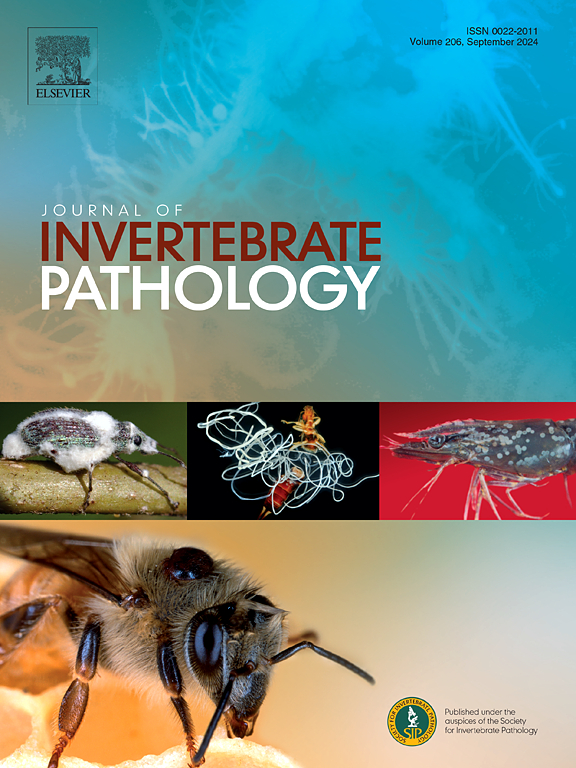Cytopathology and phylogeny of Pinna nobilis Picornavirus (PnPV) infecting haemocytes of the noble pen shell population from Lake Faro (Southern Italy)
IF 2.4
3区 生物学
Q1 ZOOLOGY
引用次数: 0
Abstract
Pinna nobilis Picornavirus (PnPv) is an RNA virus affecting the immune cells of the noble pen shell P. nobilis, which has recently been discovered in two Mediterranean countries, Spain and Italy. As part of the LIFE PINNARCA (LIFE20 NAT/ES/001265) project, a survey was performed to evaluate the health status of the P. nobilis population found in Lake Faro in Sicily (Southern Italy), previously reported as a P. nobilis sanctuary. A conservative sampling consisting of both mantle biopsies and haemolymph was performed on 6 individuals during the survey in 2023. Immune cells were observed at transmission electron microscopy (TEM) and cytology and used for RNA based qPCR. Nucleic acid extraction (DNA and RNA) was performed on the mantle biopsy to detect the presence of the parasite Haplospodium pinnae and the virus PnPv in order to establish its tropism. From TEM, we discovered that the PnPv infection was present in 100 % of the samples. The parasite H. pinnae was detected through PCR in 3 out of 6 animals (50 %); acid fast bacteria were detected in cytological preparations in 2 out of 6 individuals (33 %). Phylogenetic analyses of PnPv supported the novel virus being a member of the Marnaviridae family, likely descending from an algal host ancestor. This discovery provided some important information on evolutionary relationships and taxonomy of picornaviruses, increasing our understanding of the disease outcome and bringing new insight to the cytopathology and phylogeny of PnPV.

法罗湖(意大利南部)贵族笔壳种群血细胞感染的贵族笔壳小核糖核酸病毒(PnPV)的细胞病理学和系统发育。
Pinna nobilis小核糖核酸病毒(PnPv)是一种影响高贵笔壳P. nobilis免疫细胞的RNA病毒,最近在西班牙和意大利两个地中海国家被发现。作为LIFE PINNARCA (LIFE20 NAT/ES/001265)项目的一部分,对在西西里岛(意大利南部)法罗湖发现的贵族P. nobilis种群的健康状况进行了调查,该湖以前被报道为贵族P. nobilis保护区。在2023年的调查中,对6名个体进行了包括地幔活检和血淋巴的保守抽样。通过透射电镜(TEM)和细胞学观察免疫细胞,并采用基于RNA的qPCR。通过衣膜活检进行核酸提取(DNA和RNA)检测耳廓单形体虫和PnPv病毒的存在,以确定其趋向性。从TEM中,我们发现PnPv感染存在于100 %的样本中。6只动物中有3只(50% %)经PCR检出弓形虫;6例患者细胞学制剂中检出抗酸菌2例(33 %)。PnPv的系统发育分析支持这种新型病毒是马尔纳病毒科的一员,可能来自藻类宿主祖先。这一发现为小核糖核酸病毒的进化关系和分类学提供了一些重要信息,增加了我们对疾病结局的理解,并为PnPV的细胞病理学和系统发育提供了新的见解。
本文章由计算机程序翻译,如有差异,请以英文原文为准。
求助全文
约1分钟内获得全文
求助全文
来源期刊
CiteScore
6.10
自引率
5.90%
发文量
94
审稿时长
1 months
期刊介绍:
The Journal of Invertebrate Pathology presents original research articles and notes on the induction and pathogenesis of diseases of invertebrates, including the suppression of diseases in beneficial species, and the use of diseases in controlling undesirable species. In addition, the journal publishes the results of physiological, morphological, genetic, immunological and ecological studies as related to the etiologic agents of diseases of invertebrates.
The Journal of Invertebrate Pathology is the adopted journal of the Society for Invertebrate Pathology, and is available to SIP members at a special reduced price.

 求助内容:
求助内容: 应助结果提醒方式:
应助结果提醒方式:


